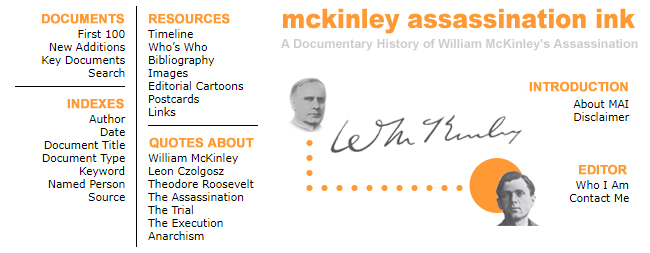|
The McKinley Monument
BUFFALO now has a McKinley statue. The unveiling has been characterized
as a “national event,” participated in by “the whole Nation,” which
has not yet recovered from the alleged great loss it had sustained
through the shot of Czolgosz.
Our Republic has grown very unrepublican.
The country our forefathers had in mind was to be the land of a
free people, enjoying equality. To-day we are ruled by Cæsars and
Crœsuses who have long since abolished the simple republican virtues.
Of the old Republic nothing remains but the name; its essence is
a plutocracy.
And the people? They are exploited
and oppressed—in the name of the people. Their bondage is skilfully
veiled by an appearance of independence and liberty. Modern governmental
policy consists in hypnotizing the enslaved masses into the belief
that they are sovereigns. [275][276]
That is the character of our democracy. Democracy and Republicanism
are twins representing the most refined political method of masking
our social and economic bondage. Democracy is the triumph of the
deception practiced upon the people; the web is spun so finely that
the ordinary man fails to see its meshes.
It is not very difficult to arouse
a people against a Nero. Yet what titanic efforts are required to
convince the citizen that his paper sovereignty is but the rope
with which his masters strangle his independence and the Nation’s
prosperity!
If the Nation and the people are identical,
what interest have the millions of America in a McKinley monument?
But if the money kings, usurers, gamblers and canned meat patriots
constitute the Nation, then it has reason indeed to glorify McKinley:
Was he not, as Chief Magistrate, their most faithful servant? It
was the representative of the money bags that Czolgosz struck down.
Let them, then, mourn his death, for they may truthfully say that
in McKinley they lost and able and zealous protector. They
have reason to mourn, to be grateful and to build monuments, to
honor the memory of their good servant.
But the Nation, the people? Have they
anything to be grateful for to McKinley? Has he ever championed
their interests? Was he their President? Was he not
ever willing and ready to suppress every manifestation of popular
dissatisfaction? Was he not constantly at the beck and call of the
capitalists, ready to put the army at their disposal whenever the
“common” people endeavored to lighten their burden? He could be
relied on at all times to aid his plutocratic friends to the extent
of his presidential power, to still further oppress and subjugate
labor. His régime, dropping all appearances, boldly revealed the
conspiracy between State and Capital, for their mutual aggrandizement
at the expense of the working masses. McKinley’s mission consisted
in the endeavor to remove the last barriers that stood in the way
of the monopolists’ complete triumph. And though such policy meant
the life-blood of hundreds of thousands, did he care? Was he moved
by the cries of the orphans and the tears of the widows, those countless
[276][277] victims of King Greed, whose
untiring and faithful servant he was?
The McKinley monument marks the final
evolution of the Jeffersonian Republic into an imperialistic plutocracy.
It symbolizes political corruption, judicial venality and a colonial
policy of brutal violence, oppression and exploitation, as practiced
on the Filipinos. It characterizes the greed for markets, land robbery
and the worst commercial instincts that the McKinley régime fostered
and encouraged. It represents Mammon, upon whose altar are daily
sacrificed countless men, women and children, whose blood is shed
for the greater glory of our Christian civilization. In fine, the
McKinley monument is the symbol of Imperialism—the mailed fist of
capitalism—whose mission it is to strangle independence and aid
capitalistic exploitation at home and abroad.
The Buffalo monument is an insult
to the American proletariat. The workingman who still retains a
spark of manhood must turn his back upon this symbol of his shame
and degradation.
The future historian, if free from
prejudice and plutocratic influence, will stamp McKinley as the
pliant tool of trusts and monopolists.
To-day the deluded still cry: “The
King is dead! Curses upon his murderer!” But greater and more lasting
than Cæsar’s fame is the beloved memory of Brutus.
|


![]()